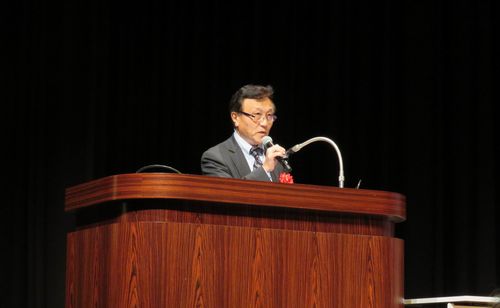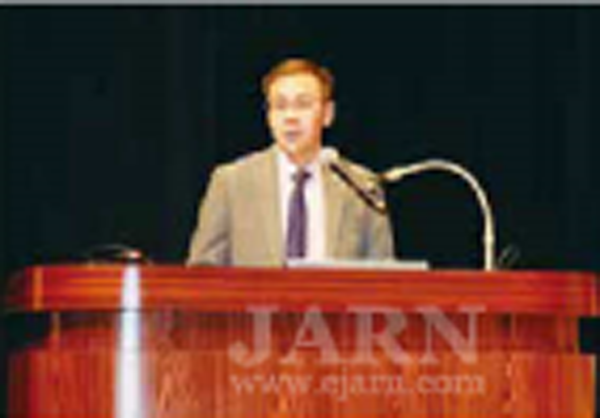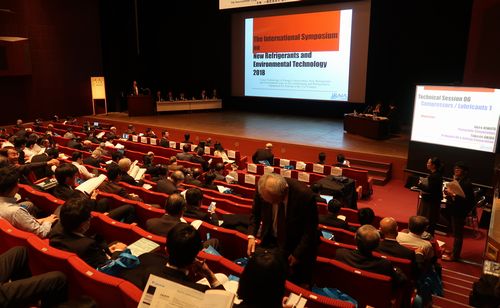—Report on Kobe Symposium 2018
The International Symposium on New Refrigerants and Environmental Technology 2018 (Kobe Symposium) was held at the Kobe International Conference Center and organized by the Japan Refrigeration and Air Conditioning Indus- try Association (JRAIA). The 13th edition of the symposium started on December 6 and ended with success on December 7.

Around 550 people from Japan and around the world participated in the symposium, a conference size second only to the 2016 symposium. Many timely topics were covered with content significant to the industry, indicating the high level of interest worldwide in environmental and refrigerant initiatives.
Many of the presentations at the symposium focused on global warming countermeasures, with topics including new heating, ventilation, air conditioning, and refrigeration (HVAC&R) equipment and new refrigerant technology development contributing to environmental conservation as well as the latest regulatory developments in Japan and abroad.

The Kigali Amendment, which was adopted at the 28th Meeting of the Parties to the Montreal Protocol (MOP28) in October 2016 in Kigali, Rwanda, came into force in January 2019, and countries are now working to meet their commitments under it. The Kigali Amendment to the Montreal Protocol was ratified by 60 parties as of November 12, 2018, which triggered its entry into force. While the obligations of the respective parties to implement environmental initiatives and the speed of their implementation vary along with their different political and economic circumstances, all parties recognize the urgency with which action on climate change needs to be taken.
The symposium began with opening remarks by Toshiyuki Takagi, chairman of the board, JRAIA, and Masatoshi Omura, executive director, Kobe Tourism Bureau. Over the two days of the meeting, participants had the opportunity to attend a wide range of technical sessions, poster sessions, and presentations.
The session started with a keynote address by Tetsuji Okada, president of JRAIA, titled ‘History of the Kobe Symposium and the Latest Issues of the HVAC Industry,’ which covered the history of the symposium, market trends, the latest developments in regulations and protocols, and global environmental protection policy and efforts.
Technical Session 1 focused on environmental issues. Toshio Kosuge from Ministry of Economy, Trade and Industry (METI) discussed the amendment to Japan’s ozone layer protection law. Presentations on the F-gas Regulation, the hydrofluorocarbon (HFC) phasedown, Ecodesign legislation, and safety standards in Europe were made by Mihai Scumpieru and Els Baert from the European Partnership for Energy and the Environment (EPEE). Xudong Wang from the Air-Conditioning, Heating, and Refrigeration Institute (AHRI) reported its research on flammable refrigerants.

A presentation titled ‘Updates on Standards Development and Revision in the Chinese R&AC Industry Following the Kigali Amendment’ was made by Huicheng Liu from the China Refrigeration and Air Conditioning Industry Association (CRAA).
Appliance manufacturers talked about new refrigerants during technical sessions 2 and 3, and lectures on the safety of refrigerants and risk assessments were delivered during technical sessions 4 and 5. Technical Sessions 6 and 7 covered compressors and lubricants. Speakers delivered presentations on energy conservation in Technical Session 8. Finally, during Technical Session 9, refrigerant manufacturers presented their findings on new refrigerants.
The sessions at the symposium gave updates on topics covered at the Kobe Symposium 2016 and on progress in refrigerant development and HVAC&R technology, among others. A2L refrigerant assessments were the main topic discussed at the Kobe Symposium 2016. For the 2018 edition, in addition to A2L refrigerants, propane (R290) and other A3-class refrigerants were discussed for the first time. Many presenters reported on the results of their verification experiments with these refrigerants. There were also many reports on alternative refrigerants to R410A and R404A. Other presentations discussed equipment development and experimental findings for new low-global warming potential (GWP) refrigerants that achieve high efficiency such as R466A, R463A, and R448A. Issues of stability and safety, namely flammability, for new refrigerants are not yet settled topics, and these refrigerants may ultimately not prove to be the solutions the industry is looking for. However, these new refrigerants and the HVAC&R technical developments related to them do shine a light on global-scale environmental initiatives and have the potential to lead to future developments.
JARN had opportunities to interview many lecturers individually during the symposium. They include Stephen Kujak from Trane, who gave a presentation titled, ‘Update on Next Generation Low GWP Refrigerants for Chiller Products,’ Masato Fukushima from AGC, who talked about ‘Next Generation Low-GWP Refrigerants AMOLEA,’ and Dr. Sarah Kim from Arkema, who delivered a lecture titled, ‘Flammability and Risk Assessment of Low Environmental Impact Refrigerants for R134a and R404A Replacement.’ JARN plans to publish these interviews in future issues.
In an interview with JARN, Tetsuji Okada, president of JRAIA, commented, “This year’s Kobe Symposium recorded the second-highest attendance ever. Experts from around the world praised the impressive content offered at this symposium. I intend to make future editions of the Kobe Symposium a venue for disseminating information on new technologies related to refrigerants and compressors.” The Kobe Symposium brings together HVAC&R experts not only from Japan but also from around the world to share the latest information on refrigerant issues that are some of the most important topics in the industry today and as such, is set to attract even more attention in the coming years.
Source: eJARN (http://www.ejarn.com/index.php)